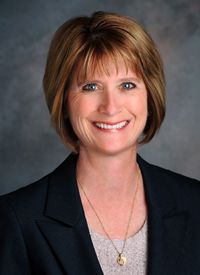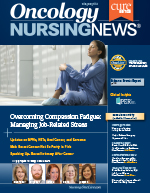Compassion Fatigue: How Nurses Can Care for Themselves
Compassion fatigue ... burnout … job-related stress. Whatever the term used to describe it, most oncology nurses will have experienced the feeling themselves or witnessed it in their colleagues, and more than likely, both.
Jillian Kenney, BSN, RN, OCN

Jillian Kenney, BSN, RN, OCN
Compassion fatigue ... burnout … job-related stress. Whatever the term used to describe it, most oncology nurses will have experienced the feeling themselves or witnessed it in their colleagues, and more than likely, both.
Burnout is a word that many people use to describe what they feel when they can no longer work effectively. It is a reaction to external forces, such as overwork, difficult working conditions, or conflicts with bosses or coworkers, and results in a breakdown in the ability to stay focused and on task.1
People from all walks of life and all professions can experience burnout, but it can go deeper among people who work in caring and giving professions like nursing. These professionals can also develop compassion fatigue (CF).
Charles Figley, PhD, now the director of the Tulane University Traumatology Institute, formally defined CF in 1995 as a combination of burnout and secondary traumatic stress, the type of stress experienced by people who care for others who are traumatized or are suffering.2
Compassion fatigue affects 16% to 39% of registered nurses. And although all nurses can experience it no matter where they practice, those at highest risk are nurses working in emergency, oncology, hospice, and pediatric settings.3
“In general terms, burnout is more of a personal experience, whereas compassion fatigue is a relational experience,” Jillian Kenney, BSN, RN, OCN, explained. “While some of the symptoms may be the same, the motivation behind those symptoms is the biggest difference.
“Someone suffering from professional burnout may feel that they don’t have adequate resources, they don’t have adequate compensation, and that leads to a dislike of their place in their company or business, whereas compassion fatigue results from the perceived lack of ability to attain a shared goal.”
That goal is the well-being of the patients. “If your patient isn’t doing well, there’s almost a subconscious sense of failure on the part of the nurse,” continued Kenney, a clinical nurse in oncology at the UCLA Medical Center in Santa Monica, California.
Compassion is a vital part of a nurse’s role, and compassion satisfaction is the positive side of being in a helping profession.4 When compassion satisfaction rates remain high, this is positive for both nurses and their patients. Patients who feel satisfied with the care they received reported better overall satisfaction with their hospital experience. But the flip side of compassion satisfaction is CF, and when satisfaction drops, risk of CF follows, as does the risk of lower quality patient care.5
Oncology Nurses at Risk
Inpatient oncology units often follow the mixed-model setting. In the course of one shift, nurses may provide care to patients who are receiving active curative treatment, while at the same time helping patients who are receiving palliative or end-of life care, depending on their assigned patient load.
Patricia Jakel, RN, MN, AOCN

Patricia Jakel, RN, MN, AOCN
By moving continuously from one situation to another, if a nurse does not feel in control or supported, he or she is at risk for CF. Patricia Jakel, RN, MN, AOCN, a clinical nurse specialist also at UCLA Santa Monica Medical Center, shared this story:
“One of my young nurses came to me. He’s a great nurse. He said to me, “The patient dies. I do what I have to do with the family, but then I have to go next door and begin the chemo on a newly diagnosed lymphoma patient, and I have to put on my happy face.” That’s really hard in a fast-paced environment. You can take 10 minutes at work, but most of us cry in our cars on the way home.”
Nurses who experience CF usually dread going to work, may have difficulty concentrating, feel nervous, anxious, or pessimistic, and have low self-esteem. Anger towards coworkers is not unusual. At first, the signs may be brushed off as having a bad shift or not feeling up to par, but as the feelings continue or intensify, this could point to CF.The Professional Quality of Life Measurement (ProQoL) tool was developed and made available for free from ProQoL.org, to help professionals analyze their feelings, and measure how they rate on scales for burnout and secondary traumatic stress.6 This measurement has been in use since 1995, and has been used extensively in CF research. Any person or facility may download and use the tool, which can be used as a starting point determining CF.
“If the Oxygen Masks Drop …”
Before every plane takes off, passengers are reminded of emergency procedures, which include instructions regarding the oxygen masks. If passengers are traveling with a child or someone who needs assistance, they are instructed to put on their own oxygen mask first, so they are able to help their companion. Nurses must take that same approach. They must take care of themselves, so they can take care of their patients and the others who need them. In her research into CF, Patricia Potter, RN, PhD, FAAN, and her colleagues determined that there were five approaches or strategies to self-care that nurses could employ, which they named compassion fatigue “antibodies.”5
- Self-regulation Learning how to relax or achieve a feeling of peace
- Perceptual maturation Learning how to regulate thinking and perception
- Intentionality Writing a covenant and choosing how to live and work
- Connection and support Developing and using a support network
- Self-care and revitalization Healthy living, participating in hobbies, etc
Self-care approaches provide nurses with a variety of options, from keeping gratitude journals to taking regularly scheduled vacations. Becca Hawkins, MSN, ARNP, ACHPCN, the Director of Compassionate Care at Providence Health & Services in Pendleton, Oregon, likes to promote mindfulness as a part of self-care. She has done extensive research and teaching about mindfulness and meditation for nurses. She uses this approach as self-care because it can be done anywhere any time—literally in the moment.
Jon Kabat-Zinn, founder of the Mindfulness-Base Stress Reduction (MBSR) program described mindfulness as an “awareness that arises through paying attention, on purpose, in the present moment, nonjudgmentally.”7
“We’ve been working a lot throughout our healthcare system with mindfulness. We’ve been starting with self-compassion, and paying attention to when you’re really hard on yourself, and beating yourself up over a situation or just being negative,” Hawkins said. “When this happens, you’re not able to see the positive things.”
A good place to start with mindfulness is when nurses are washing their hands. After all, how many times a shift do nurses wash their hands, Hawkins asked. “As you’re using the hand sanitizer, you just really feel your hands, listen to your heart, feel your breath, feel whatever practices you do and it brings you back here, instead of thinking, “I’m walking into this room and I’m going to have to break bad news,” she explained.
With mindfulness, there is no looking back at what happened or forward at what might happen.
Most nurses do already know what they should do in order to prevent CF, but knowing what to do and actually doing it are two different things.
Kenney and Jakel learned of an app that would help nurses remember to use these strategies. They initiated a study to evaluate the use of the Provider Resilience Mobile App among oncology nurses. Originally designed by the Department of Defense for those who cared for Iraqi war veterans, the app was adapted for nurses for the study. Kenney described the app as something that would remind nurses to do the small pieces of daily self-care.
Becca Hawkins, MSN, ARNP, ACHPCN

Becca Hawkins, MSN, ARNP, ACHPCN
“From there, it offers various resilience builders, and also helps you with your resilience killers,” Kenney explained. “It helps you see some of the negative coping strategies that you might be using and not realize you’re using. It also offers very simple resilience builders that you can do throughout the day.” The app asks when the provider last did a positive act, but it also asks things like when was the last time the user ate junk food, sat for too long, and so on, to help identify unhealthy behaviors as well.
Also included in the app is a version of the ProQoL so users can do an initial assessment, and it measures compassion satisfaction and possible levels of burnout or potential secondary traumatic stress.
Jakel pointed out that there is no one-size-fits-all approach to preventing or dealing with CF. “I think it’s a combination, be it self-care, or meditation,” she said. “I really liked that the app had daily affirmations that you could read through. The app was easy because it was there, and it was one measurement, one thing, one intervention that people could do to build their resilience.” Practicing gratitude and setting intentions is another form of self-care. Gratitude journals can help nurses focus on themselves and the positive things that are in their life. Hawkins believes that the act of physically writing down three gratitudes at night sets the stage for your brain to relax, allowing you to wake up with a positive mindset. This is followed by starting your day with your intention. “This is the day I’m going to….”
Changing the Culture
The issue of CF cannot be dealt with by the nurses alone. According to Hawkins, part of the problem in dealing with CF among nurses starts with acknowledging that it is happening. “Half the workforce is burned out,” she said. “It’s interesting, because what other industry allows people to participate in the job when they’re impaired [from burnout]? It’s been shown over and over again in the literature that when you’re burned out, there’s a higher risk for errors, there’s more sickness, etcetera.”
Now that we know that CF is a problem, we have to start taking care of ourselves and each other. “That means we have to acknowledge what is hard in healthcare,” Hawkins explained.
“What is hard about oncology nursing? What do we do with all of the suffering we have born witness to? Where do we put that?” The leadership needs to put programs into place that allow the nurses to express their feelings and to help them deal with them. The leadership needs to hear what the nurses are saying without getting defensive, Hawkins said. Those in charge have to be able to listen when their nurses are talking, without thinking that the nurses are being disloyal or disgruntled.
Can Compassion Fatigue Be Avoided?
There is a school of thought that says that you cannot develop compassion fatigue if you take care of yourself and practice mindfulness.
In a personal reflection piece published in the Journal of Palliative Medicine, palliative care physician Lisa Marr asks, “Can compassion fatigue?” According to Marr, in order for there to be compassion fatigue, there must be a finite amount of compassion in the first place. When this finite amount runs out, it needs to be replenished, and it starts over again.
“I believe that if we are truly engaged in that moment, not focusing on ourselves or worrying about where I should or could be at that moment, but truly engaged in the interaction with the other person, then compassion cannot fatigue, and frankly, burnout is less likely to occur.”8
This brings us back to mindfulness: “If we are wholeheartedly engaged in each moment, responding to what is in front of us, not judging or labeling ourselves or others, then I believe compassion cannot fatigue. Compassion can arise anew in each situation, each moment, since it is a response to what is in front of us. It’s what we do, not who we are,” Marr concluded.
Takeaway Points
- Compassion fatigue (CF) is estimated to affect 16% to 39% of registered nurses, and especially affects those practicing in emergency, oncology, and hospice settings.
- Moving continuously from one situation to another can increase risk for CF.
- The Professional Quality of Life Measurement (ProQoL) is available online and can help assess for CF.
- To avoid CF, practice self-care and self-compassion, eg, gratitude journals, taking regularly-scheduled vacations, and mindfulness “in the moment”.
- “Acknowledge what is hard in healthcare”—engage institutional leadership to improve the culture and support nurses.
References
- US Library of Medicine. PubMedHealth. Depression: What is burnout syndrome? http://1.usa.gov/1TrS2wy. Accessed April 2, 2016.
- Figley CR. Compassion Fatigue: Coping with Secondary Traumatic Stress Disorder in Those Who Treat the Traumatized. Levittown, PA: Brunner/Mazel; 1995.
- Potter P, Deshields T, Berger JA, et al. Evaluation of a compassion fatigue resiliency program for oncology nurses. Oncol Nurs Forum. 2013;40(2):180-187.
- Stamm BH. Compassion Satisfaction and Compassion Fatigue. April 26, 2012. http://bit.ly/1Hr8Cad. Accessed April 2, 2016.
- Potter P. Compassion Fatigue: Prevalence Among Oncology Nurses. Presented at: Missouri Oncology Society Spring 2015 Membership Meeting; April 14, 2015. http://bit.ly/25DtAx1. Accessed April 2, 2016.
- Professional Quality of Life Scale (PROQOL). Compassion Satisfaction and Compassion Fatigue. http://bit.ly/1OWPcb. Accessed April 2, 2016.
- Jon Kabat-Zinn: Defining Mindfulness. Mindful. January 11, 2016. http://bit.ly/1O0pqZs. Accessed April 2, 2016.
- Marr L. Can compassion fatigue? J Palliat Med. 2009; 12(8):739-740. http://bit.ly/1X7nnnb. Accessed April 2, 2016.

Innovative Program Reduces Nurse Turnover and Fosters Development
Published: September 12th 2024 | Updated: September 12th 2024The US Oncology Network (The Network) has developed one of the most comprehensive programs in the nation to support the professional development and retention of new oncology nurses.



